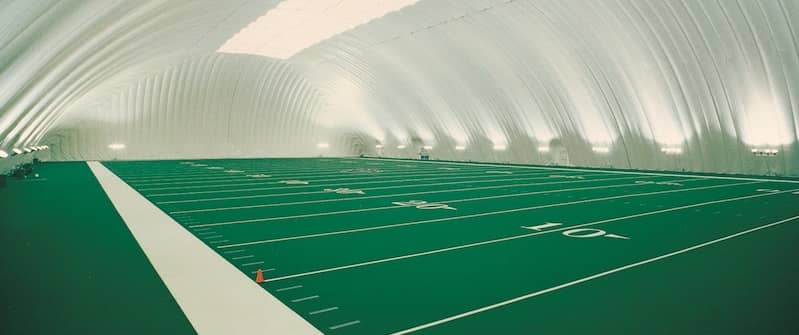 Our favorite NFL and NCAA football teams are conditioned to play and perform in all types of weather. However, when extreme conditions prohibit these teams from practicing outdoors, a structure that provides a constant temperature suitable for training is the logical solution. Learn more about the advantages of air-supported dome structures in both hot and cold climates, and the fabric options associated with air-supported domes.
Our favorite NFL and NCAA football teams are conditioned to play and perform in all types of weather. However, when extreme conditions prohibit these teams from practicing outdoors, a structure that provides a constant temperature suitable for training is the logical solution. Learn more about the advantages of air-supported dome structures in both hot and cold climates, and the fabric options associated with air-supported domes.
Advantages of Air Structure Domes
Air-supported dome structures provide year-round practice opportunities for teams in the NFL and the NCAA. Teams that normally brave frigid temperatures throughout the season benefit from a heated facility for practice and year-round training purposes. Air-supported dome structures can also benefit teams that are based in warmer climates such as the Miami Dolphins or the Tennessee Titans by providing an air conditioned environment during the hot and muggy months. These air-supported dome structures are built as NFL training houses and embody full-sized fields with surrounding space available for staff. The all-encompassing facilities are large enough to be considered full-sized indoor stadiums, thus providing a realistic training environment for the teams. Other benefits include the mobility and flexibility of the air-supported domes. The air-supported dome structures are movable, making the structure flexible in multiple locations. The structure can also be taken down when the weather conditions are suitable for practicing.
Translucent vs. Opaque Fabric
Air-supported dome structures can be built with translucent and/or opaque fabrics. Many structures utilize a combination of both fabrics when framing a facility. Typically, the sides of the dome are made up of opaque fabric covered by an insulation layer. There is normally space at the top of the dome for a translucent layer, which allows light to enter the dome, thus decreasing the cost of lighting for the facility. The fabric make-up of the structure depends on the specific design requirements set at the beginning of the construction process. The benefits of combining both translucent and opaque material allow training facilities in any climate to retain heat or air conditioning. This ultimately leads to cost savings.
Acrylic, PDVF (Polyvinylidene Fluoride) and Tedlar Top Coats
After choosing the type of dome, the fabric and the weight of the fabric, the next step is to choose the type of top coat for the structure. Typically, there are three kinds of top coat: Acrylic, PVDF and Tedlar. The types of coating vary in performance with Acrylic being the basic foundational choice, PVDF adding a bit more longevity to the top finish and Tedlar acting as the best top coat for your structure. Regardless of which coating you choose for your design needs, they all share the following characteristics:
- Colorfastness
- Retention of gloss
- Dirt pickup
- Mildew resistance
- Cleanability
- General Resistance
The Tedlar coating historically performs the best out of the three options, and therefore increases the overall life expectancy of the air-supported dome structures.
It is important to consider the translucent/opaque fabric and coating applied to the air-supported dome structures before they are utilized by NFL and NCAA teams. Air-supported dome structures have become an integral part of a team’s success both on and off the field by providing an ideal environment suitable for year-round professional level training.
Do you have any experience with air structure domes used as sporting facilities? Tell us about it in the comments!


